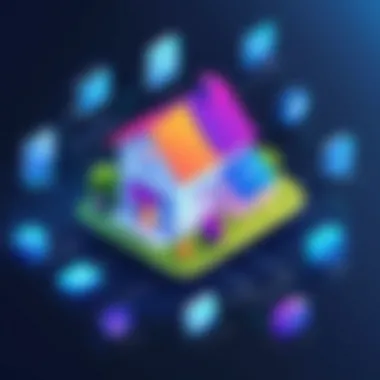Exploring Mortgage Origination Software Solutions


Intro
In the competitive realm of real estate and finance, where the slightest misstep can lead to significant losses, the role of mortgage origination software emerges as critical. This software provides the backbone for efficient mortgage origination processes, designed to simplify workflows for lenders, brokers, and real estate professionals. Understanding this landscape isn’t just for those already in the industry; it’s essential for anyone aiming to make informed decisions in this complex environment.
Navigating the nuances of these software solutions requires a firm grasp of current trends, features, and the multifaceted challenges faced by users. As technology continues to evolve, staying ahead of the game is no small feat. Yet, with the right guide, stakeholders can shift through the noise and pick the software that aligns with their specific needs and aspirations.
The insights provided here will dig into industry currents, popular software options, key selection criteria, implementation strategies, and future projections, all to equip decision-makers with the knowledge they need to make optimal choices as they chart their course through this intricate landscape.
Prolusion to Mortgage Origination Software
Navigating the world of mortgage origination software is akin to embarking on a journey through a complex, ever-evolving landscape. For stakeholders within the mortgage industry — be it lenders, brokers, or real estate professionals — understanding this topic is vital not just for operational efficiency but also for maintaining a competitive edge in a slightly cluttered market. This segment outlines the significance of mortgage origination software and zeroes in on elements that make it indispensable in today’s financial climate.
Definition and Purpose
To put it simply, mortgage origination software functions as a tool designed to facilitate and streamline the process of issuing loans. It integrates various components of the mortgage process, from application submission to underwriting, and culminates in the final approval of the loan. The primary purpose of such software is to enhance efficiency, minimize human error, and ensure compliance with an ever-shifting regulatory environment.
Many professionals find that automation not only expedites their workflow but also enhances customer satisfaction, a pillar that cannot be overlooked in a highly competitive marketplace.
Evolution of Mortgage Origination Solutions
The roots of mortgage origination software go back a few decades, where processes were predominantly manual. In those days, each piece of paperwork had to navigate various hands, often resulting in delays and miscommunication. Today, technology has reshaped this landscape dramatically. Cloud computing, artificial intelligence, and big data have transformed basic software into comprehensive suites that can analyze risk, forecast market trends, and even offer personalized mortgage advice.
The evolution didn’t happen overnight; however, as new challenges and opportunities arose, software developers worked diligently to refine these tools.
Some notable trends in recent years include:
- Integration of machine learning algorithms to enhance risk assessment
- Improved user interfaces that prioritize customer experience
- Expansion of API capabilities to allow smooth integration with other financial software
Understanding this evolution is crucial. It provides a backdrop against which decision-makers can evaluate current solutions, consider the most effective features, and ultimately choose software that aligns with their operational needs.
"The landscape of mortgage origination software has changed more in the last decade than in the previous twenty years, creating both complexities and opportunities."
Key Features of Effective Software
When it comes to choosing mortgage origination software, the stakes can be high. The right software can significantly enhance efficiency, ensure compliance, and ultimately improve customer experiences. Thus, understanding the key features of effective software is pivotal for decision-makers looking to invest in a tool that meets their intricate needs. In this section, we will delve into the essential characteristics that should not be overlooked when evaluating these solutions.
User Interface and Experience
The difference between a good software and a great one often lies in its user interface (UI) and overall user experience (UX). A well-designed UI allows users to navigate through the platform seamlessly, reducing the learning curve and promoting productivity. Intuitive design leads to less frustration. Users should be able to handle tasks without getting bogged down by complex menus or unresponsive buttons.
For instance, if the software offers a dashboard that displays real-time processing status, it can save users from hunting for information. Making informed decisions becomes easier when essential data is at their fingertips.
Moreover, engaging visuals can enhance comprehension. When combined with tailored features catering to specific user roles, this becomes a game changer.
Integration Capabilities
In today’s technology-driven world, no software operates in a vacuum. The ability to integrate with existing systems is crucial for mortgage origination software. These tools must connect with various platforms like customer relationship management (CRM) systems, data verification services, and financial accounting systems.
Consider a scenario where the origination software syncs automatically with a CRM like Salesforce. This capability allows for real-time updates and reduces data entry errors. Options like APIs enable seamless data transfer, minimizing disruptions during workflow. The value is clear: better interoperability translates to a more cohesive operation.
Compliance Management Tools


Navigating the myriad regulations governing the mortgage industry can be daunting. Compliance management tools within mortgage origination software serve as guardrails ensuring that lending practices meet legal standards. These features can automate aspects of compliance, such as tracking changes in laws or updating requisite documentation.
It's essential to look for software that not only provides compliance checks but also integrates audit trails that can be accessed easily. This means that in the event of an inquiry, lenders can swiftly produce the necessary documentation and evidence.
Reporting and Analytics Features
Data without actionable insights holds little value. Thus, the inclusion of robust reporting and analytics features in origination software is non-negotiable. Such tools enable stakeholders to pull detailed reports on various KPIs, including loan processing times and bottlenecks in the pipeline.
Imagine being able to identify patterns in loan approvals based on previous data. Effective analytics can provide predictive insights, empowering users to make strategic adjustments in their sales approaches or operational processes. This foresight can ultimately lead to enhanced customer satisfaction and better financial outcomes.
Customer Relationship Management (CRM) Functions
In an industry driven by relationships, having integrated CRM functions in your mortgage origination software can significantly boost productivity. These features not only help in tracking client communications but also enable personalized engagement based on client history and preferences.
For example, if a user can see a client's previous inquiries and feedback all in one place, it enhances their ability to offer tailored advice and service. This added layer of relationship management can be the difference between gaining a loyal customer and merely closing a transaction.
In essence, having robust CRM functions can foster long-term client relationships, which is invaluable in the competitive mortgage landscape.
In summary, the effective mortgage origination software must possess a suite of features tailored to facilitate ease of use, ensure compliance, provide analytical insights, and enhance customer relations. These elements form the backbone of a productive and responsive software solution, ultimately ensuring better outcomes for all stakeholders involved.
Comparative Analysis of Leading Providers
When it comes to mortgage origination software, a thorough comparative analysis of the leading providers is absolutely essential. Given the myriad of options available, decision-makers need to look beyond surface features to understand which solutions truly align with their needs. In such a pivotal industry, where efficiency and accuracy can make or break a business, knowing who’s who and what they bring to the table is vital. By evaluating the strengths, weaknesses, and market roles of each provider, stakeholders can make informed choices that drive their operations towards success.
Overview of Major Players in the Market
The mortgage origination software landscape is dotted with several prominent players, each claiming to cater to the needs of different segments of the market. Some of the major contenders include:
- Encompass by Ellie Mae: Widely recognized for its extensive features and seamless integrations.
- Mortgage Builder: Known for its user-friendly interface and adaptability.
- Calyx Software: Offers robust mortgage loan processing capabilities, especially for small to mid-size lenders.
- Calyx Point: A popular choice, especially amongst brokers for its straightforward usage.
This list, while not exhaustive, paints a clear picture of who the key players are and hints at their unique selling propositions. As such, decision-makers should assess not only these software platforms' functionalities but also how they complement their business models.
Strengths and Weaknesses of Each Solution
Understanding the strengths and weaknesses of these leading providers is crucial for tailoring a solution that aligns with specific operational needs. Here's a closer look:
- Encompass by Ellie Mae:
Strengths: Comprehensive features set, strong analytics, great customer service.
Weaknesses: Can be overwhelming for new users due to complex functionality. - Mortgage Builder:
Strengths: Intuitive UI, customizable workflows.
Weaknesses: Limited integration capabilities with third-party tools. - Calyx Software:
Strengths: Strong customer support, reliable processing speeds.
Weaknesses: Less feature-rich compared to other platforms, may require supplementary tools for full functionality. - Calyx Point:
Strengths: Simple user experience, cost-effective for small firms.
Weaknesses: Lacks some advanced reporting capabilities.
Having a clear picture of these aspects helps potential buyers pinpoint which attributes are non-negotiable for their operations.
User Reviews and Case Studies
Real-world feedback is perhaps the most crucial element in evaluating any software. User reviews often shine a light on practical implications that marketed features might overlook. Through varied case studies and personal testimonials, stakeholders gain insights into how actual users experience the software.
- Positive Feedback:
- Critiques:
- Users often praise Encompass for its robust analytics and reporting capabilities, which many find invaluable for optimizing their business decisions.
- Similarly, Mortgage Builder receives accolades for its user-friendly interface, leading to shorter onboarding times for employees.


- Some users of Calyx Software express a desire for more advanced features, indicating it might lack what’s necessary for larger lenders or those seeking more analytics capability.
- Calyx Point users sometimes mention its basic feature set, pointing to a need for additional tools to streamline processes further.
Ultimately, pulling insights from user reviews allows potential adopters to grasp the realities of each solution, ensuring their choice aligns with real-world expectations and outcomes.
Considerations for Choosing the Right Software
Choosing the right mortgage origination software is critical in today’s fast-paced real estate environment. With technology evolving at a breakneck pace, the right software can either propel a business forward or hold it back. Therefore, understanding the nuances and considerations in this decision-making process is vital.
It’s not just about having the latest bells and whistles; it’s about determining which features align best with the specific needs of your operations. From user interface to compliance management, there is much to ponder. Here, we explore essential elements that influence the selection process, underlining the benefits they bring.
Size and Scale of Operations
When evaluating mortgage origination software, the scale of your operations plays a pivotal role. A small brokerage with only a handful of lenders will have different needs compared to a large institution processing thousands of mortgages daily.
- Customization Levels: Smaller firms might find that a cookie-cutter solution suffices, whereas larger players often need more bespoke features. The software should be adaptable enough to accommodate varying volumes and complexities.
- User Count and Access: As teams grow, it may become necessary to cater to multiple users. Make sure your software license can address this need without breaking the bank.
The bottom line is that the software must grow alongside your business. Choosing one that can scale ensures that you won’t have to go hunting for a new system down the line.
Budgetary Constraints and Cost-Benefit Analysis
Let’s face it—money talks. Understanding your budget and potential ROI before diving into a purchase is essential.
- Upfront vs. Ongoing Costs: While affordability can be a pressing concern, don’t overlook the total cost of ownership, which includes hidden fees, maintenance charges, and upgrades over time.
- Value for Features: Consider what each feature costs versus the benefits it brings. For instance, having robust analytics tools may cost more initially, but the insights they provide can lead to smarter lending decisions and ultimately higher profitability.
Diving deep into a cost-benefit analysis enables stakeholders to make informed choices that fit within their financial framework, without compromising on essential capabilities.
Adaptability and Future-Proofing Features
In a landscape that’s constantly shifting—thanks to changing regulations, technology advancements, and market demands—the adaptability of your software cannot be overlooked.
- Integration with Emerging Technologies: Your software should seamlessly integrate with newer technologies, such as artificial intelligence and blockchain. If the foundations of your system can expand with advancements in the industry, you’re setting your business up to thrive in the long run.
- Regular Updates: Evaluate how often the software provider pushes out updates and patches. A company that is slow on this front may fall behind in compliance and functionality, potentially leaving users vulnerable.
"Invest wisely in software that can adapt to change; it’s your best defense against the unknowns of tomorrow."
In summary, considering factors like operation size, budget constraints, and adaptability will aid decision-makers in selecting the right mortgage origination software. These choices will not only impact immediate processes but shape the long-term trajectory of their businesses.
The Impact of Technology Trends
In the ever-evolving arena of mortgage origination, technology trends play a pivotal role in shaping the way lenders, brokers, and other professionals navigate the complex processes associated with home financing. Keeping a close eye on these trends is not merely beneficial; it’s often essential for maintaining a competitive edge. As the digital landscape considerably alters the playing field, understanding how these technologies transform practices can provide insight into future developments in the industry.
The integration of advanced technologies can lead to enhanced efficiency, improved customer experiences, and greater compliance capabilities. Particularly, the advent of artificial intelligence and blockchain technology represents a significant shift in how organizations manage data, streamline processes, and ensure security.
Exploring these trends is more than a passing glance at innovation; it’s about grasping how technology improves operations, mitigates risks, and drives decision-making. As such, the impact of these trends will be examined in detail, providing a roadmap for decision-makers and IT professionals working within the mortgage origination framework.
Artificial Intelligence in Mortgage Processing
Artificial intelligence has entered the mortgage industry with a bang, reshaping how loans are processed. One of the foremost contributions of AI lies in automating repetitive tasks, like data entry and document verification. This not only reduces human error but also frees up professionals’ time, allowing them to focus on more strategic aspects of their roles.


- Automated Decision Making: AI algorithms can assess credit risks and evaluate borrower eligibility with astonishing speed. This capability accelerates the decision-making process, potentially leading to quicker loan approvals and enhanced client satisfaction.
- Predictive Analytics: By leveraging historical data, AI can forecast trends and borrower behavior. This insight allows lenders to tailor offerings and expand customer outreach efforts more effectively.
However, the deployment of AI isn't without its challenges. Professionals must weigh the pros and cons of implementing such technology while staying compliant with regulations. Understanding the ethical implications and ensuring transparency in AI decision-making processes are crucial as organizations adopt these systems.
Blockchain Integration and Security Enhancements
Blockchain technology stands out as another significant forward leap, especially in ensuring data integrity and security within the mortgage landscape. At its core, blockchain offers a decentralized ledger system that enhances transparency while minimizing the risk of fraud—a major concern in real estate transactions.
- Immutable Records: Every transaction on a blockchain is time-stamped and cannot be altered. This provides a clear trail of ownership and can significantly reduce disputes over property titles.
- Smart Contracts: By utilizing smart contracts, parties can automate aspects of the loan agreement, including the disbursement of funds upon meeting predetermined conditions. This not only expedites transactions but also reduces the reliance on intermediaries, trimming unnecessary costs.
Incorporating blockchain into mortgage origination necessitates understanding the technical intricacies while also recognizing the regulatory landscape surrounding cryptocurrency and data privacy laws. The shift towards blockchain could well signify a monumental change in how mortgage processes are executed—from application to closing.
"Embracing new technology like AI and blockchain is not merely about adopting trends but about transforming the enterprise into a more agile, compliant, and customer-centric machine."
As the mortgage industry continues to evolve, aligning with these technologies and understanding their profound implications will be paramount for stakeholders aiming to stay relevant and competitive.
Regulatory Environment and Compliance
The mortgage industry navigates a complicated maze of regulations and compliance standards. Understanding these rules is not merely a matter of keeping the wolves at bay; it’s essential for building trust and maintaining a sound business reputation. A firm grasp of regulatory compliance not only protects against legal pitfalls but also promotes a competitive edge in an increasingly crowded market.
The landscape can shift like sand underfoot, with the introduction of new laws or amendments to existing regulations. For example, the Dodd-Frank Act and the Real Estate Settlement Procedures Act (RESPA) dictate the disclosure of fees and the prohibition of kickbacks. Such regulations directly affect mortgage origination processes, making it vital for professionals to stay abreast of these changes. Firms that develop a deep understanding of these legal nuances can significantly reduce their risk of non-compliance and its associated penalties.
Understanding Regulatory Compliance
Regulatory compliance refers to the adherence to laws, regulations, guidelines, and specifications relevant to the mortgage industry. It's a broad term, encompassing everything from how customer data is handled to the transparency of fee structures. Here’s what decision-makers should focus on:
- Data Protection: The General Data Protection Regulation (GDPR) and the California Consumer Privacy Act (CCPA) have heightened focus on how customer information is used and stored. Adapting systems to meet these standards prevents hefty fines and builds client trust.
- Fair Lending Practices: Regulations under the Equal Credit Opportunity Act (ECOA) mitigate discrimination in lending. This compels lenders to refine their origination processes to ensure that all applicants are assessed on equal footing.
- Transparency: Clear disclosure of terms and conditions is a must. Standards requiring detailed breakdowns of loan costs are essential to protect consumers and maintain the integrity of the mortgage sector.
Understanding these components and incorporating them into the software can streamline compliance efforts and mitigate risk.
Software Adaptations to Regulatory Changes
The agility of mortgage origination software in adapting to regulatory changes can be a game changer. Not only does this adaptability enhance compliance, but it also promotes operational efficiency. Here are some core adaptations that software providers can implement:
- Dynamic Compliance Updates: Utilizing software that integrates real-time updates regarding regulatory changes ensures that lenders can adjust their practices without delay.
- Auditing Features: Built-in audit trails help track compliance-related activities. This transparency allows firms to provide accurate documentation during inspections or audits.
- Automated Reporting: Many regulatory frameworks require regular reporting. Automated systems can generate these reports in accordance with specified standards, cutting down on manual errors and saving time.
- User Training Modules: Implementing educational tools within the software can help staff stay informed about compliance requirements, paving the way for a culture of adherence to regulations.
End and Future Outlook
The realm of mortgage origination software is not just a passing fad; it’s a cornerstone of the current financial landscape. As lenders and mortgage professionals navigate an increasingly complex market, understanding the significance of these tools becomes vital. This article has illuminated the multi-layered benefits, key features, and the dynamism that characterizes this sector.
With this understanding, various stakeholders can make informed decisions that align their operational goals with the most effective software solutions available. The fusion of technology and compliance is a tightrope walk that necessitates continuous oversight and adaptation. Ignoring this aspect can lead to grave consequences in terms of both efficiency and compliance; thus, it’s paramount to stay updated.
Moreover, understanding future trends is essential for organizations aiming to maintain competitive advantage. The integration of advanced technologies, especially the likes of AI and blockchain, is not merely about hopping on the latest tech bandwagon; it's about genuinely optimizing processes to drive down costs and improve customer experience.
"In an industry where the time is often money, staying ahead of technological advancements provides a significant edge."
Key Takeaways
- Importance of Adaptability: The best mortgage origination software must evolve with market demands, ensuring it remains relevant to users’ needs. Software that can adapt to future changes—technologically and legislatively—will likely dominate the market.
- User-Centric Design: A focus on user experience can greatly enhance productivity. Tools that simplify complex processes will gain favor among users who appreciate robust functionality without the headache.
- Compliance is Non-Negotiable: In this regulated environment, an understanding of compliance management tools can’t be overlooked. Organizations must ensure that their software solutions can swiftly adjust to any regulatory changes.
Predictions for Industry Evolution
- Greater AI Utilization: We can anticipate a surge in AI applications within mortgage origination. This includes automating tedious documentation processes and creating predictive analytics to better understand borrower behavior.
- Blockchain for Transparency: As security concerns mount, the adoption of blockchain for improving transparency in transactions is likely to increase. This will not only enhance trust among users but also streamline processes like title verification.
- Personalized User Experiences: Expect to see more personalized interfaces that cater to the specific needs of different user groups. A one-size-fits-all approach will give way to tailored experiences, making the software feel less like a tool and more like a partner in operations.
- Increased Integration: Future solutions will increasingly feature seamless integration capabilities with existing CRM, accounting, and marketing tools, allowing a holistic approach to mortgage management.
In summary, the mortgage origination software landscape is poised for transformative changes. Being aware of these trends not only helps stakeholders to stay ahead but also enables them to choose solutions that can grow and shift alongside their operational needs. The path ahead is filled with opportunities, provided one is willing to navigate it effectively.



